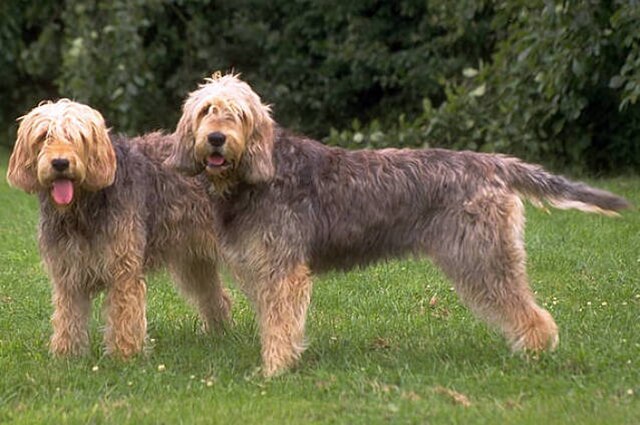


The Otterhound is a large, powerful, and unique breed known for its exceptional sense of smell and strong swimming abilities. Originally bred to hunt otters in the rivers and marshlands of England, the Otterhound is a skilled tracker with a thick, weather-resistant coat and a distinctive appearance. The breed is affectionate, playful, and friendly, making it a great companion for families who have the space and time to meet its exercise and grooming needs. Despite its hardworking past, the Otterhound is a gentle and social dog that enjoys the company of people and other pets.
The Otterhound's origins date back to medieval England, where it was bred specifically for hunting otters. These dogs were used by hunters to track and pursue otters in rivers, marshes, and other wetland environments. The breed was developed from a mix of hounds, including the Bloodhound and other hunting breeds, to create a dog that could excel in water and possess a strong, persistent sense of smell. Otterhounds were highly valued during the 19th century, particularly for their ability to track otters, which were considered a nuisance to fishermen. However, as hunting otters became less common, the breed's popularity declined. Today, the Otterhound is a rare breed, though it is still used in some places for tracking and hunting. It is also cherished as a family companion and show dog.
The Otterhound is a large, sturdy dog with a strong and muscular build. On average, males stand about 27 inches at the shoulder and weigh between 115 to 130 pounds, while females are slightly smaller. The breed has a distinctive long, rough coat that is weather-resistant and waterproof, which helped it endure the harsh conditions while hunting in water. Otterhounds come in various colors, including grizzle and tan, blue and tan, or a combination of black, tan, and white. The breed has a broad head with a wrinkled brow, large, floppy ears, and deep-set eyes that give it a somewhat solemn expression. Their long tail is typically carried high, and they have webbed feet, which assist them in swimming. The Otterhound's face is often described as rugged, with a noble yet affectionate expression.
The Otterhound is known for being friendly, affectionate, and social. This breed typically bonds strongly with its family and is known to be good with children and other pets. Otterhounds have a playful side, and their friendly nature makes them excellent companions. While they are generally calm and laid-back indoors, they are highly energetic and can be quite mischievous outdoors. Otterhounds have an independent streak due to their history as hunting dogs, which means they can sometimes be stubborn or difficult to train. However, they are loyal and protective, and they tend to get along well with other dogs. They may be reserved or aloof around strangers but are rarely aggressive. The breed's strong prey drive means that they may be inclined to chase smaller animals, so early socialization and training are important to ensure they are well-behaved.
The Otterhound is an active and energetic breed that requires plenty of exercise to stay healthy and happy. Given its history as a hunting dog, the Otterhound loves outdoor activities, especially those involving water, such as swimming, running, and hiking. Regular daily walks, along with time spent in a securely fenced yard, are necessary to satisfy the breed’s physical activity needs. Otterhounds enjoy playing games like fetch and can excel in activities such as agility and scent work, which allow them to use their tracking abilities. However, despite their high energy levels, Otterhounds are usually calm indoors and enjoy lounging with their family after a good exercise session. Owners should ensure that their Otterhound gets a sufficient outlet for its energy to prevent boredom and destructive behavior.
The Otterhound is an intelligent breed, but it can be somewhat independent and stubborn, which can make training a challenge. Positive reinforcement methods, such as treats and praise, work best with this breed, as they respond well to gentle encouragement rather than harsh discipline. Early socialization is crucial for an Otterhound to develop into a well-adjusted adult. Exposing them to a variety of people, animals, and environments early on helps ensure they become confident and comfortable in different situations. Training should be consistent and patient, as Otterhounds may not always be eager to please but will learn with time and repetition. Due to their strong prey drive, it is important to keep an Otterhound on a leash during walks and in areas with wildlife unless it is in a securely enclosed space.
The Otterhound is generally a healthy breed, but like all dogs, it is prone to certain health issues. Common health concerns include hip dysplasia, elbow dysplasia, and progressive retinal atrophy (PRA). Regular veterinary checkups are essential for monitoring the dog's health and detecting potential problems early. The breed's long, rough coat requires regular grooming to prevent mats and tangles. Otterhounds should be brushed several times a week, and they may require occasional baths to keep their coat clean and healthy. Regular ear cleaning is also necessary to prevent infections, as the breed's floppy ears can trap moisture and debris. Otterhounds are also prone to dental issues, so regular teeth brushing is recommended to maintain good oral health.
The average lifespan of the Otterhound is between 10 to 13 years. With proper care, including regular veterinary visits, a balanced diet, and adequate exercise, the breed can live a long and healthy life. Like many larger breeds, Otterhounds are prone to certain health conditions, so owners should monitor for any signs of illness and provide prompt treatment when needed. Ensuring that the dog maintains a healthy weight and gets sufficient exercise will help to manage common health issues and promote longevity.
© copyright Dog Compendium 2024 - 2025